Entering cost of sales or direct costs
The Cost of Sales or Cost of Goods Sold (COGS) refers to the direct costs of producing the goods sold by a company. This amount includes the cost of the materials and labor directly used to create the goods. It excludes indirect expenses, such as distribution costs and sales force costs. To deliver your product or service to your customers, you'll incur some necessary costs. If you manufacture your product, for example, you'll have to spend money on raw materials and labor. If you're a retailer, you'll likely have to spend money buying products wholesale. If you're a restaurant, you'll have to spend money on raw ingredients and servers.
Service-based businesses often have a smaller number of direct costs than product-based businesses, but they still have direct costs in most cases.
If you're not sure whether a cost is a Cost of Sales, here's a good rule of thumb: if you want to know if an expense falls under COGS, ask: "Would this expense have been an expense even if no sales were generated?" Meaning if you sold no product at all this month, would you still have this cost to pay? If the answer to that question is no, then the cost is most likely a cost of sales.
To learn more about the cost of sales and operating expenses, see: What is the difference between the cost of sales and expenses?
We give you three ways to forecast the cost of sales: General costs, Revenue-specific costs, and Direct personnel costs (Direct labor). The cost of sales form guides you on how to enter/edit the cost of sales data:

You can also add personnel cost of sales(direct labor), that is, personnel such as factory workers or servers, whose expenses you want to treat as cost of sales(direct costs).
In this article
Why is the Cost of sales important?
If your cost of sales is going up, you're earning less profit. It might be time to start looking for new suppliers or cut costs in your business.
Separating the cost of sales from other expenses also lets you understand your gross margin. This key metric, which appears in the Profit and Loss statement, is calculated this way:
Gross Margin = Revenue – Cost of Sales
Gross margin is a good top-line measure of how efficiently your company is at delivering its products and services. Not only that, it tells you how much profit your business has on hand to cover its operating expenses. (A larger gross margin means that after those operating expenses are paid, you'll still have profit left over.)
Entering Costs for General Costs
- 1
-
In the Cost of Sales stream, under the General Costs option. Add the group name. Click on the Add Group of Costs and add the name of the cost group.
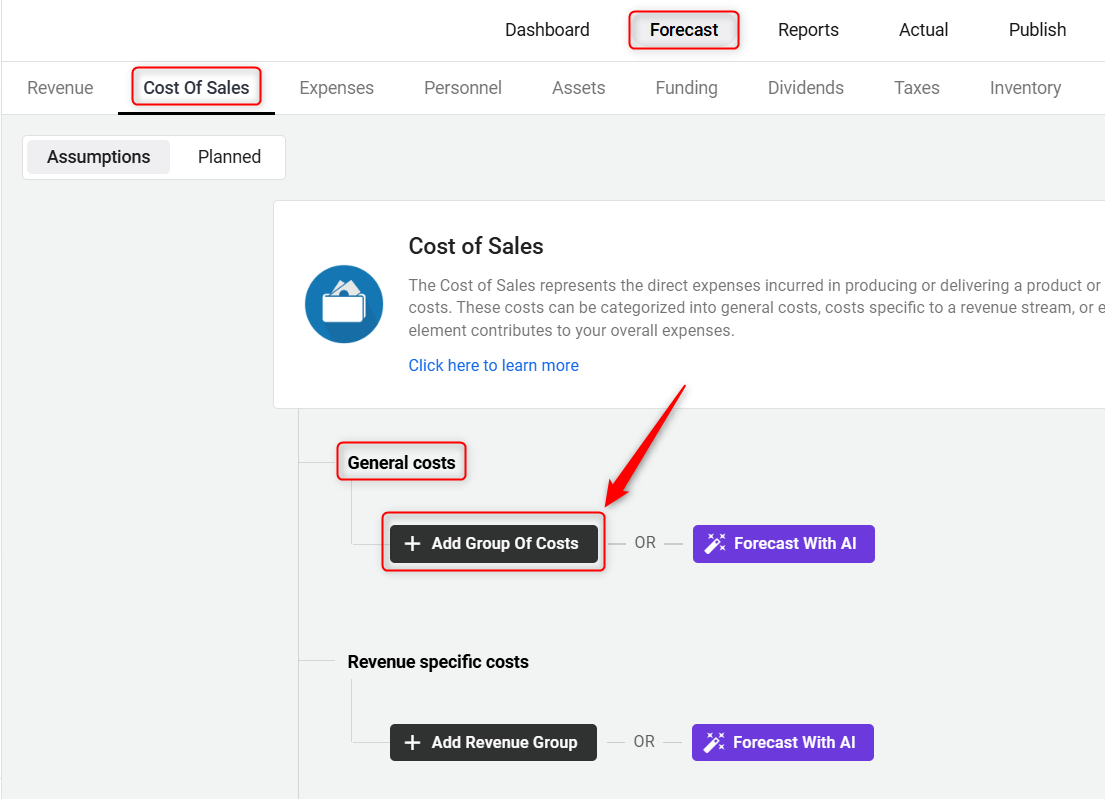
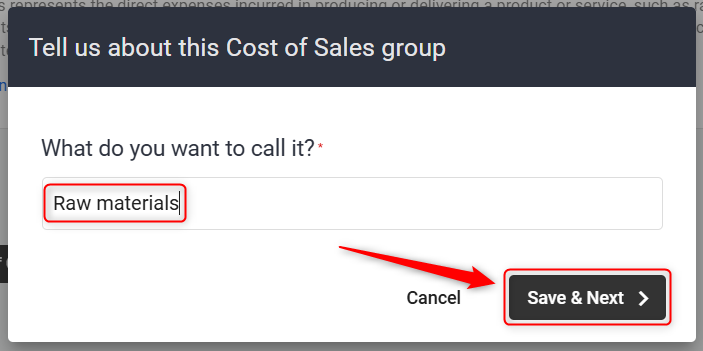
- 2
-
Enter the name of the expense and select the appropriate option for adding this expense:

- Constant Amount: Select this option when you have a constant amount of cost of goods sold. For example, you are paying a fixed amount Monthly, Quarterly, or Yearly.
- Per Unit: Select this when the cost of goods sold varies directly with the number of units bought.
- Per Employee: Use this when your cost depends on the number of employees. Enter the cost per employee, and the system will auto-calculate based on your team size.
- % of overall revenue: Best to use when the Cost of goods sold is associated as a percentage of overall revenue or revenue of a specific revenue stream.
- % of other cost of Sale: Select this if your cost is a percentage of another cost of sale. Choose the related cost and specify the percentage value to link them.
- One-time or varying amount over time: If none of the above models are applicable, or you already have a detailed forecast in Excel or elsewhere, choose this option and just enter overall cost values without any details.
- 3
-
Fill in the required fields and click on Save. Then the Cost of Sales Chemicals Forecast Sheet is overlaid for review.
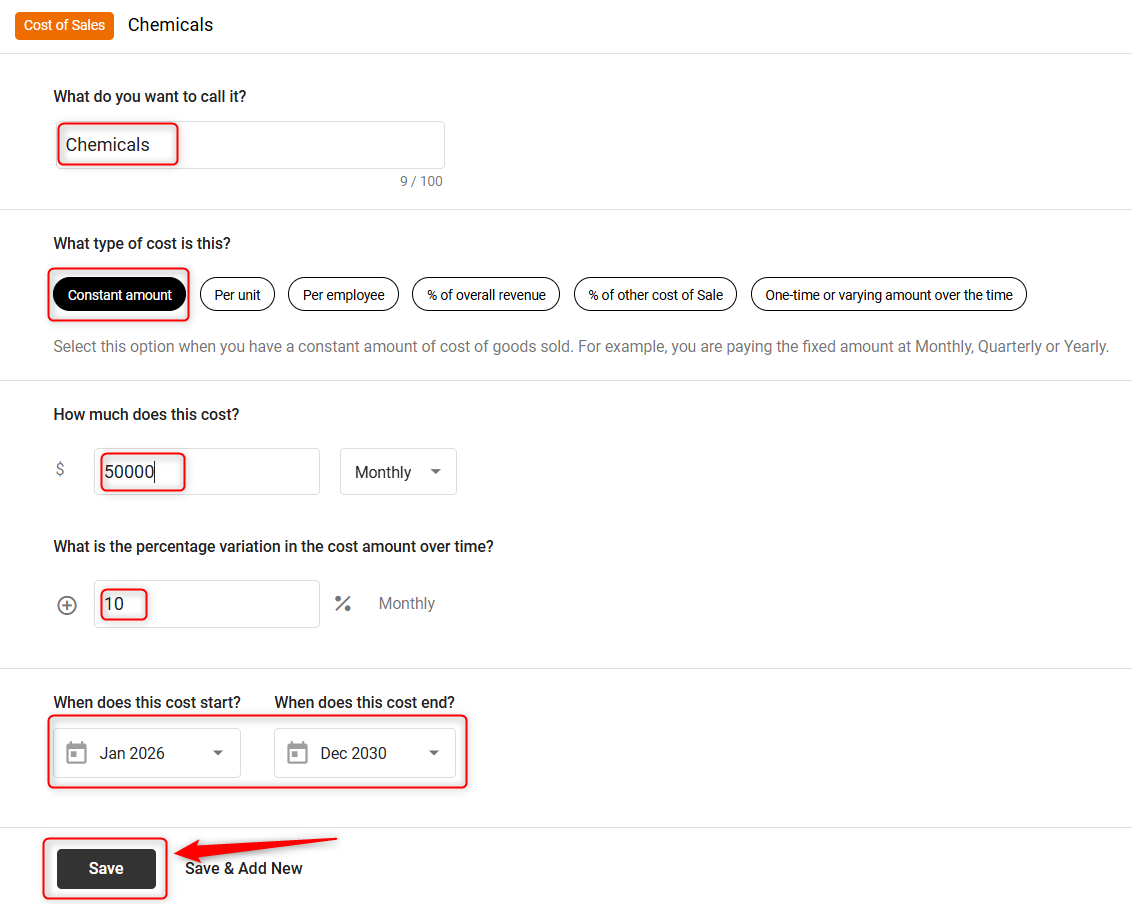
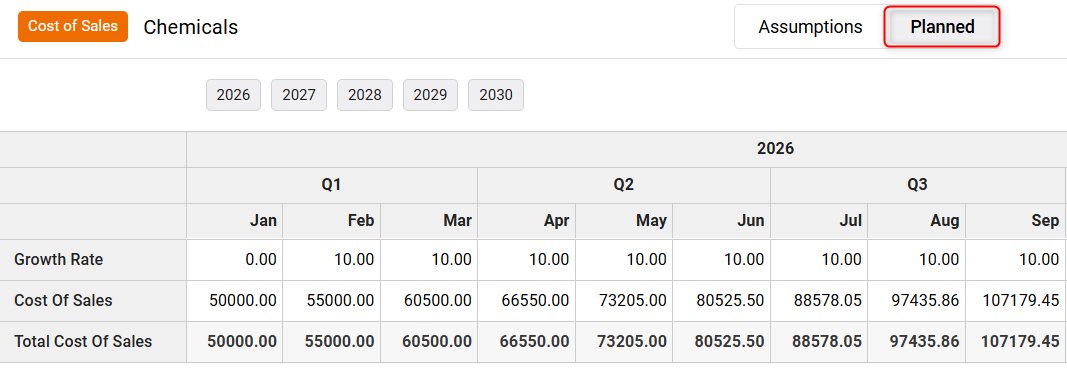
Entering Costs for a Specific Revenue Stream
We recommend using this method whenever possible.
NOTE: The cost of sales entered under a specific revenue stream can only be linked to that revenue stream.
- 1
-
In your Finance Forecasting module, under the Forecast tab, click on the Cost of Sales tab, and then under Revenue specific costs, click on the Add Cost of Sales option:

- 2
-
In the overlay that appears, Select Cost of Sales type from the list:

- If you choose Constant Amount, enter the amount of this cost to apply to each day/week/month/quarter/year of your plan. (The cost can represent a per-unit, per-customer, or per-hour cost, depending on the revenue stream you selected).
- If you choose Per unit sales, Best to use when there are some costs that are directly associated with the unit sales of a product or service, or customer.
- Per Employee Expense is most effective when you're dealing with costs that inherently depend on the number of employees.
- % of revenue: Choose this if your cost is a fixed percentage of your income. You can link it to overall revenue or a selected revenue stream/item for accurate cost tracking.
- If you choose a one-time or varying amount over time, if none of the above models are applicable, or if you already have a detailed forecast in Excel or enter the amounts of the unit cost in any months in which you'll incur them:
- 3
-
Enter the cost amount and percentage change, then click Save to apply the update. Vehical maintenance and repairs forecast sheet is overlaid for review.


Editing or Deleting the Cost of Sales:
- 1
-
To delete a cost of sales, click on Delete item to remove the cost of sales item:

TIP: Moving finance items from one group to another is hassle-free. For a detailed walkthrough, check out our help guide here.
- 2
-
To edit the cost of sales, click on the Edit option on the cost of the sales item.
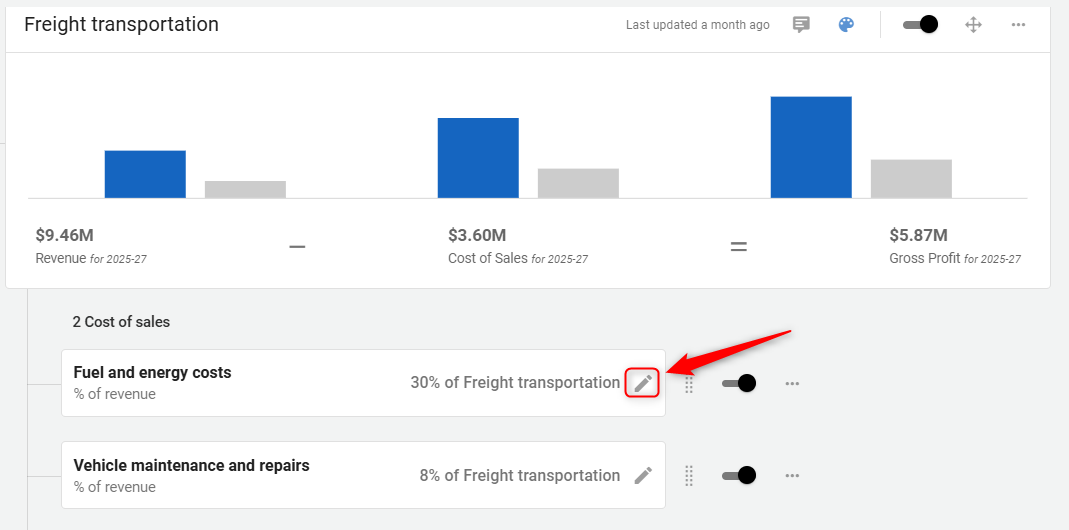
Where does this entry appear in the financial statements?
The only financial statement in which you'll see your cost of sales listed by name is the Profit and Loss:

The cost of sales is calculated in the Balance Sheet and Cash Flow statement, but not explicitly. Instead, your cost of sales is used to calculate your available cash, which appears in the Assets portion of the Balance Sheet:

In the Cash Flow Statement, your cost of sales is part of the highlighted lines below:












